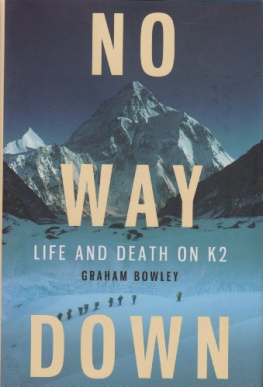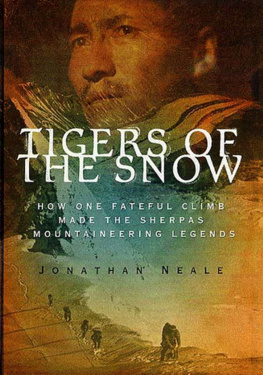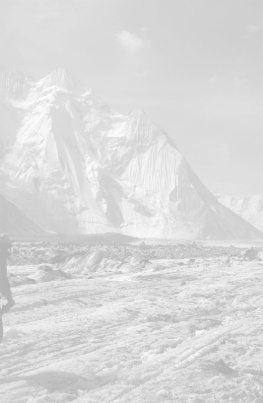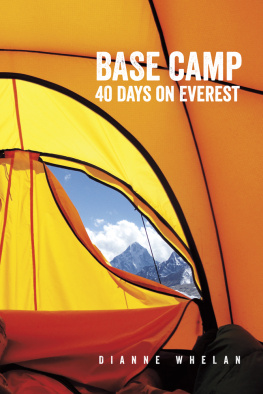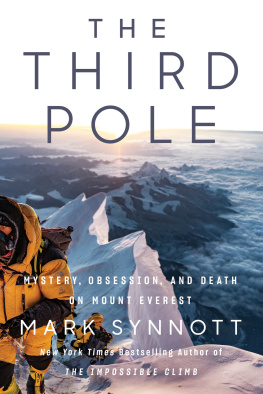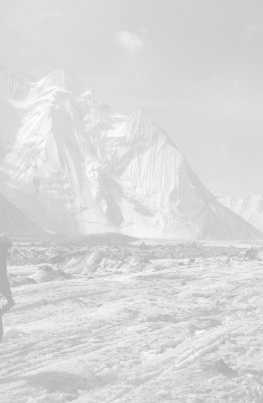To my mother and father,
and to Chrystia
Beware of the man whose God is in the skies.
George Bernard Shaw, Man and Superman
Take care to fly a middle course.
Daedalus advice to Icarus, Ovid, Metamorphoses
I long for scenes where Man has never trod.
John Clare
The story of how a multinational group of climbers became trapped by a falling glacier at the top of K2 flashed across my screen at the New York Times on August 5, 2008. Once it was confirmed that eleven climbers had died indulging a private passion for their expensive sport and three had finally come down frostbitten but alive after surviving several nights in the open, my immediate reaction was, Why should we care?
When my editor suggested I write about their ordeal for the newspaper, I balked at the ideamountaineering had never interested mealthough the next morning my story appeared on page one of the paper.
It was only after the Times s website was deluged with comments from fascinated readers and after I took a trip abroad a week and a half later to the memorial service of one of the climbers that I began to entertain the possibility that there was more to the story. I interviewed some of the still-haggard survivors of the accident, saw their injuries, and, I must admit, was inspired by the charisma of the adventurers who had stepped into a world I could not understand and had faced down death.
I set about interviewing as many climbers as I could from the expeditions, as well as their families, and the mountaineering experts who had spent time on K2. As I talked to the survivors, I found their stories were often disturbing, painful, and occasionally incomprehensible. On the face of it, a thirty-nine-year-old reporter who had never been to the Karakoram range was an unsuitable candidate to comprehend the fascination and dangers of modern mountaineering. However, some of the considerations that might seem to have disqualified me actually played to my advantage. Already, by this point, the accounts were contradicting one another and it was clear that memory had been affected by the pulverizing experience of high altitude, the violence of the climbers ordeals and, in a few instances, possibly by self-serving claims of glory, blame, and guilt. I realized one of the advantages I had in making sense of the story was my objectivity and distance from the events. And some of the climbers seemed to agree. In Stavanger, Norway, after I had strolled for three hours around the city with Lars Nessa, a remarkable young Norwegian climber, he turned to me to say, We think you are the one to tell our story.
Anyway, by then I was hooked. I had stepped with these men and women into a foreign world somewhere above the Baltoro glacier and I could not turn back.
When I began working on this book, I wanted to write a story that read dramatically, like fiction only real. I would bring K2 alive through the eyes of the courageous climbers who were pursuing their dreams on this incomparable peak in the Himalayas. Re-creating the final days of eleven people who would never return from K2 posed some challenges. The book I have written is based on hundreds of interviews with the many dozens of people involved directly or indirectly with the tragedy. If I couldnt determine exactly what happened on the slopes, I interviewed the climbers who had been close at pivotal moments, or experts who had been through similar situations, or families or friends who knew the climbers well. Never did I rely on conjecture; in cases where firsthand accounts were not available, I drew on my knowledge of the characters of the climbers and on as much evidence as I could gather over a year.
As my goal was to write a book re-creating the experiences of the climbers caught up in this tragedy, I needed to report dialogue. With only a few exceptions, the dialogue was quoted to me directly by the speakers involved. In many of the important scenes I checked back to ensure accuracy and this often jogged memories or caused people to rethink. Right from the start I knew it was essential to interview the climbers early on, before memories faded, but in a very few cases, primarily those in which climbers did not survive, I have re-created the dialogue based on my impressions of the people involved as gleaned from my interviews.
I conducted the majority of the interviews in person, with follow-up conversations by telephone or email. Drawing on these resources, I have written as complete an account as possible of a narrative that involves multiple points of view. In the end, though, there are certain questions that I found impossible to resolve. My approach has been to set out as accurately as possible each climbers account, even where the accounts conflict. Some of the most crucial aspects of the tragedy turn on those points of conflict. The full truth of what actually took place in those August snows at 28,000 feet may never be known.
One June day, I followed the trail of the climbers to K2 and stood for a few hours in the cold sunshine on the Godwin-Austen glacier. I stared up more than two miles at the South Face, then climbed two hundred feet to the Gilkey Memorial, K2s monument to the dead. Seeing up close the peak, the Great Serac, and the Bottleneck, contemplating their beauty and their challenge, I could start to understand why this brave group of men and women would risk their lives to climb it.
Those names marked in bold denote climbers who made a serious summit bid on August 1, 2008.
NORWEGIAN K2 EXPEDITION 2008
Rolf Bae
Cecilie Skog (leader)
Lars Flato Nessa
Oystein Stangeland
NORIT K2 DUTCH INTERNATIONAL EXPEDITION 2008
Wilco van Rooijen (leader)
Cas van de Gevel
Gerard McDonnell
Roeland van Oss
Pemba Gyalje
Jelle Staleman
Mark Sheen
Court Haegens
ITALIAN K2 EXPEDITION 2008
Marco Confortola (leader)
Roberto Manni
SERBIAN K2 VOJVODINA EXPEDITION 2008
Milivoj Erdeljan (leader)
Dren Mandic
Predrag Zagorac Iso Planic
Shaheen Baig
Mohammed Hussein
Mohammed Khan
Miodrag Jovovic
2008 AMERICAN K2 INTERNATIONAL EXPEDITION
Eric Meyer
Chris Klinke
Fredrik Strang
Chhiring Dorje
Paul Walters
Michael Farris (leader)
Chris Warner
Timothy Horvath
SOUTH KOREAN K2 ABRUZZI SPUR FLYING JUMP EXPEDITION
Kim Jae-soo (leader)
Go Mi-sun
Kim Hyo-gyeong
Park Kyeong-hyo
Hwang Dong-jin
Jumik Bhote
Chhiring Bhote
Big Pasang Bhote
Little Pasang Lama
Lee Sung-rok
Kim Seong-sang
Son Byung-woo
Kim Tae-gyu
Lee Won-sub
Song Gui-hwa
BASQUE INDEPENDENT CLIMBER
Alberto Zerain
FRENCH-LED INDEPENDENT K2 EXPEDITION
Hugues dAubarde (leader)
Karim Meherban
Qudrat Ali
Jahan Baig
Nicholas Rice
Peter Guggemos
SERBIAN INDEPENDENT CLIMBER
Joselito Bite
OTHER INDEPENDENT CLIMBERS
Nick Nielsen
Christian Stangl
George Egocheago
FRENCH TGW 2008 K2 EXPEDITION
Yannick Graziani
Christian Trommsdorff
Patrick Wagnon
SUNNY MOUNTAIN CHOGORI EXPEDITION
George Dijmarescu (leader)
Rinjing Sherpa
Mingma Tunduk Sherpa
Mircea Leustean
Teodora Vid
K2 TALL MOUNTAIN EXPEDITION
Dave Watson
Chuck Boyd
Andy Selters
SINGAPORE K2 EXPEDITION 2008
Robert Goh Ee Kiat (leader)
Edwin Siew Cheok Wai
Ang Chhiring Sherpa
Jamling Bhote
ITALIAN BROAD PEAK & NANGA PARBAT EXPEDITION
Mario Panzeri
Daniele Nardi
Friday, August 1, 2008, 2 a.m.
E ric Meyer uncurled his tired body from the Americans tent into the jolt of the minus-20-degrees morning.

